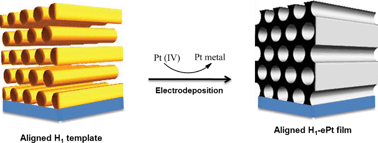2D hexagonal mesoporous platinum films exhibiting biaxial, in-plane pore alignment†
Abstract
The synthesis of 2D hexagonal mesoporous platinum films with biaxial, in-plane pore alignment is demonstrated by

* Corresponding authors
a
Department of Chemistry, The University of Reading, Whiteknights, Reading, RG6 6AD, Berkshire, UK
E-mail:
j.m.elliott@reading.ac.uk
Fax: +44 (0) 118 378 6331
Tel: +44 (0) 118 378 6342
The synthesis of 2D hexagonal mesoporous platinum films with biaxial, in-plane pore alignment is demonstrated by

 Please wait while we load your content...
Something went wrong. Try again?
Please wait while we load your content...
Something went wrong. Try again?
K. A. Asghar, J. M. Elliott and A. M. Squires, J. Mater. Chem., 2012, 22, 13311 DOI: 10.1039/C2JM31731A
To request permission to reproduce material from this article, please go to the Copyright Clearance Center request page.
If you are an author contributing to an RSC publication, you do not need to request permission provided correct acknowledgement is given.
If you are the author of this article, you do not need to request permission to reproduce figures and diagrams provided correct acknowledgement is given. If you want to reproduce the whole article in a third-party publication (excluding your thesis/dissertation for which permission is not required) please go to the Copyright Clearance Center request page.
Read more about how to correctly acknowledge RSC content.
 Fetching data from CrossRef.
Fetching data from CrossRef.
This may take some time to load.
Loading related content
